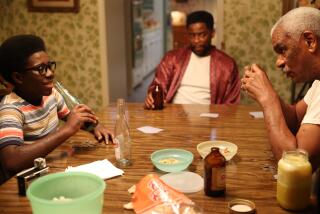From the Archives: The Kathy Fiscus Story: Turning Point in TV News
- Share via
Stan Chambers, who died Friday at the age of 91, wrote this piece for The Times on the 40th anniversary of the Kathy Fiscus tragedy:
Old letters and newspaper clippings from yellowed and crumbling scrapbooks helped me sharpen the memories of that April weekend in San Marino 40 years ago when rescuers tried to save 3-year-old Kathy Fiscus. She had fallen into an abandoned well shaft that was only 14 inches in diameter and became trapped more than 100 feet underground.
Kathy had been running and playing with her cousins in an open field covered with tall spring grass when she disappeared that Friday. Her cries could be heard, but she was nowhere to be seen.
Kathy’s mother screamed for help and emergency crews soon converged on the field and the rescue attempt began.
As efforts continued Saturday, one of television’s brilliant pioneers, KTLA General Manager Klaus Landsberg, made the decision to provide live coverage. All programming and commercials were canceled, and Bill Welch and I began our open-ended, uninterrupted reports from the scene that afternoon.
KTLA’s marathon, 27 1/2-hour coverage of the rescue attempt was one of the turning points in television history.
Up until then, television was a flickering new novelty and not taken seriously by many people. This telecast changed that view forever. People were irresistibly drawn to the tragic reality that was taking place on the screen of their living-room set. It was a television experience they would remember a lifetime.
I still have several people tell me each week how vividly they remember the Kathy Fiscus telecast.
It seemed as if all of Los Angeles stopped to watch the drama unfold. Neighbors who had rarely spoken to each other became close friends as they sat in front of black-and-white television sets. They sipped coffee and munched on sandwiches throughout the night. A hard-boiled city poured out its tears and silent prayers as frantic men worked in a dark tunnel trying to rescue a little girl.
Then came the devastating moment Sunday night when a doctor used a public address system to announce that Kathy was dead. Tired, dirty, beaten men with 40 and 50 hours of constant work behind them wept openly with bitter tears. Rescuers stood silently, heads bowed, unwilling to accept the news. The crowd of thousands was stunned. Viewers at home felt the pang of sorrow. There was no way to express the loss.
The only solace was the fact that she probably died shortly after she fell into the well Friday night and did not suffer long.
The outpouring of mail after the Kathy Fiscus telecast was overwhelming and emotional. It also bore witness to the powerful, yet intimate role that television would come to play in its viewers’ lives.
“Until last night, the television set was no more a threat to serenity than any other bit of furniture in the living room. Now you have utterly destroyed this safety forever. . . ,” wrote a man named Stewart Stern.
“You and the epic of which you have been a part of this weekend have made us know that we belong to the world. Through your own dignity and your recognition of the dignity of others, you have given us a flash of people at their best, as we remember them in the battle, or as I’ve just seen them at the Negev outposts in Israel. Many of us had seen you with your polite faces and amiable voices, but none of us had known you until the voices lost their amiability and the polite faces were beginning to sprout beards, along with our own, and you became a part of the rest who will never be forgotten by those of us who saw you there.”
More to Read
Sign up for Essential California
The most important California stories and recommendations in your inbox every morning.
You may occasionally receive promotional content from the Los Angeles Times.













